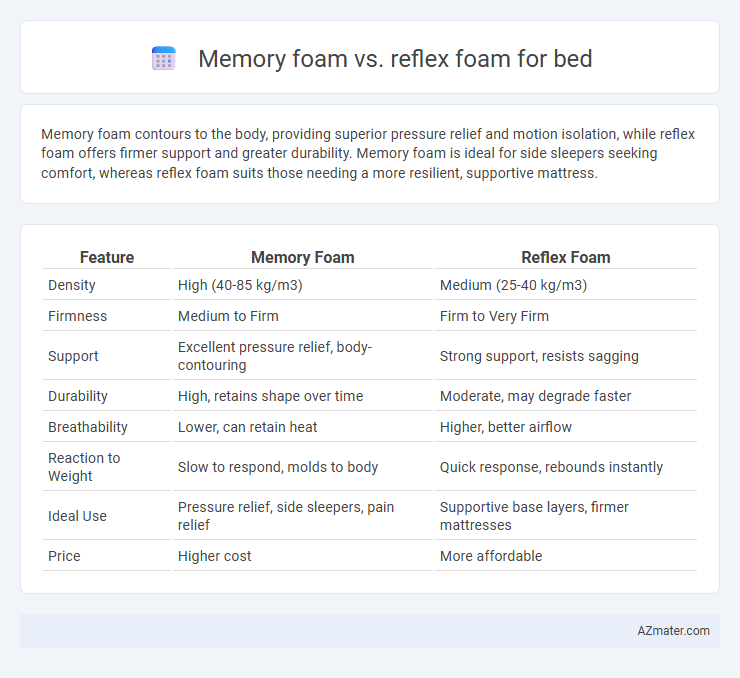Memory foam contours to the body, providing superior pressure relief and motion isolation, while reflex foam offers firmer support and greater durability. Memory foam is ideal for side sleepers seeking comfort, whereas reflex foam suits those needing a more resilient, supportive mattress.
Table of Comparison
| Feature | Memory Foam | Reflex Foam |
|---|---|---|
| Density | High (40-85 kg/m3) | Medium (25-40 kg/m3) |
| Firmness | Medium to Firm | Firm to Very Firm |
| Support | Excellent pressure relief, body-contouring | Strong support, resists sagging |
| Durability | High, retains shape over time | Moderate, may degrade faster |
| Breathability | Lower, can retain heat | Higher, better airflow |
| Reaction to Weight | Slow to respond, molds to body | Quick response, rebounds instantly |
| Ideal Use | Pressure relief, side sleepers, pain relief | Supportive base layers, firmer mattresses |
| Price | Higher cost | More affordable |
Introduction to Memory Foam and Reflex Foam
Memory foam, crafted from viscoelastic polyurethane, offers superior contouring and pressure relief by responding to body heat and weight, making it ideal for personalized comfort and support. Reflex foam, also known as high-resilience foam, provides a firmer, more resilient surface with excellent bounce and durability, commonly used for base layers and support structures in mattresses. Choosing between memory foam and reflex foam depends on desired comfort level, motion isolation, and mattress longevity.
Key Differences Between Memory Foam and Reflex Foam
Memory foam molds to the body's shape by responding to heat and pressure, providing superior contouring and pressure relief compared to reflex foam, which is denser and more elastic, offering firmer support and quicker recovery to its original shape. Memory foam excels in motion isolation and reduces pressure points, making it ideal for pain relief and comfort, while reflex foam provides better breathability and durability with more resilient support suitable for those who prefer a firmer feel. The key differences lie in memory foam's slow response and body-hugging properties versus reflex foam's fast rebound and robust spinal alignment support.
Comfort and Support Comparison
Memory foam provides superior comfort by contouring to the body's shape, relieving pressure points, and offering personalized support, which helps reduce motion transfer during sleep. Reflex foam, made from highly resilient polyurethane, delivers firmer support and quicker response to movement, promoting proper spinal alignment and durability over time. Combining memory foam's cushioning properties with reflex foam's structural support often results in a balanced mattress that enhances overall sleep quality.
Durability and Lifespan
Memory foam offers superior durability and a longer lifespan compared to reflex foam, typically maintaining its supportive properties for 8 to 10 years. Reflex foam, known for its high-density structure, provides firm support but tends to degrade faster, usually lasting around 5 to 7 years before noticeable sagging occurs. Choosing memory foam enhances long-term comfort and resilience, making it a preferred option for extended bed use.
Motion Isolation Performance
Memory foam excels in motion isolation by contouring closely to the body and absorbing movement, which minimizes disturbance between sleep partners. Reflex foam, while offering firmer support and quicker response to pressure, tends to transfer more motion due to its denser and more resilient structure. Choosing memory foam mattresses is ideal for those prioritizing minimal motion transfer during sleep.
Temperature Regulation and Breathability
Memory foam adapts closely to body contours but tends to retain heat due to its high density and limited airflow, often resulting in less effective temperature regulation and breathability. Reflex foam offers improved ventilation with its open-cell structure, facilitating better airflow and cooler sleep surfaces, which enhances temperature regulation significantly. Choosing reflex foam over memory foam benefits individuals who prioritize a breathable mattress that prevents overheating throughout the night.
Allergy and Hypoallergenic Properties
Memory foam is naturally resistant to dust mites and mold, making it a preferred choice for allergy sufferers seeking hypoallergenic bedding. Reflex foam, while offering good support and durability, tends to be more porous, which can allow allergens like dust mites to accumulate over time. Choosing memory foam mattresses with CertiPUR-US certification ensures low emissions of harmful chemicals, enhancing indoor air quality for sensitive individuals.
Pricing and Value for Money
Memory foam mattresses typically cost more than reflex foam due to their advanced pressure-relieving properties and durability. Reflex foam offers a more affordable option with good support but lacks the contouring comfort of memory foam, making it suitable for budget-conscious buyers. Evaluating value for money depends on preferences for long-term comfort and support, with memory foam providing better longevity and pain relief benefits.
Ideal Users for Memory Foam vs Reflex Foam
Memory foam is ideal for individuals seeking superior pressure relief and body contouring, especially beneficial for those with chronic pain, arthritis, or joint issues. Reflex foam suits users who prefer a firmer, more supportive surface with enhanced durability, making it suitable for people who sleep on their stomach or back and require better spinal alignment. Athletes and heavier individuals often favor reflex foam due to its resilience and ability to maintain support over prolonged use.
Final Verdict: Which Foam is Best for Your Bed?
Memory foam offers superior contouring and pressure relief by adapting to body shape, making it ideal for those with joint pain or who prefer a softer, more supportive mattress. Reflex foam provides greater durability and bounce with a firmer feel, suitable for sleepers who favor responsiveness and strong edge support. Choosing the best foam depends on your comfort preference, sleeping position, and pain management needs, with memory foam excelling in pressure alleviation and reflex foam delivering enhanced firmness and longevity.

Infographic: Memory foam vs Reflex foam for Bed
 azmater.com
azmater.com